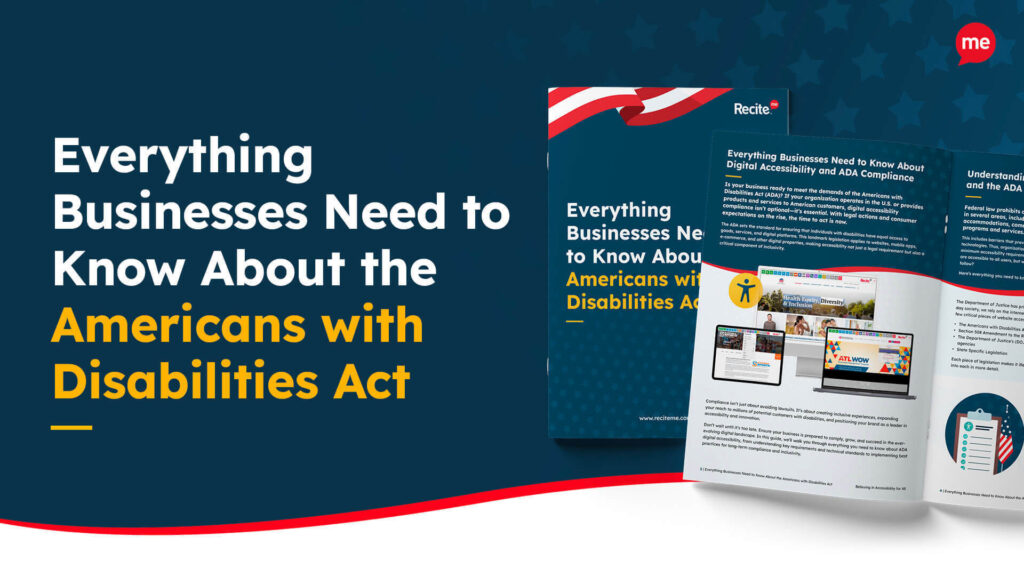Download Our Free ADA Compliance Checklist
Download NowWith over 6 million live websites, WooCommerce is a digital powerhouse for ecommerce stores. The free, open-source plugin transforms WordPress websites into online stores, with tools to create product listings and process orders.
WooCommerce is a strong contender for creating ecommerce sites, but what about accessibility? That’s where ADA compliance can help.
ADA compliance ensures that your online store is accessible to all, regardless of ability. In this post, Recite Me will explore common WooCommerce ADA compliance issues and how to address them.
How does the ADA apply to WooCommerce stores?
The Americans with Disabilities Act is an anti-discrimination law that requires equal opportunities and treatment for disabled people. It applies across many areas of public life, including in the workplace, public services, and the private sector.
The ADA requires companies to apply reasonable adjustments to enable disabled people to access and engage with their products/services. Wheelchair access is a well-known example, but accessible websites are another important accommodation.
Government agencies, businesses, and non-profit organizations are all required to comply, including online. Along with Squarespace and BigCommerce stores, it’s also essential for WooCommerce stores. For digital accessibility, the Web Content Accessibility Guidelines (WCAG) provide the gold standard to adhere to.


Are there any built-in WooCommerce accessibility features that aid ADA compliance?
WooCommerce has several built-in accessibility features and capabilities, including:
- Compatible with screen readers and keyboard-friendly navigation
- Semantic HTML and ARIA roles for improved screen reader accessibility
- Accessible forms with descriptive input labels and clear error messages
Keep in mind that you’ll also need to ensure your WooCommerce theme is accessible, as themes can override some standard accessibility features. “Responsive” and “Storefront” are both good options for accessible themes.
Get a free automated ADA compliance audit of your website. This audit will highlight compliance violations and provide the recommendations needed to meet ADA compliance standards.
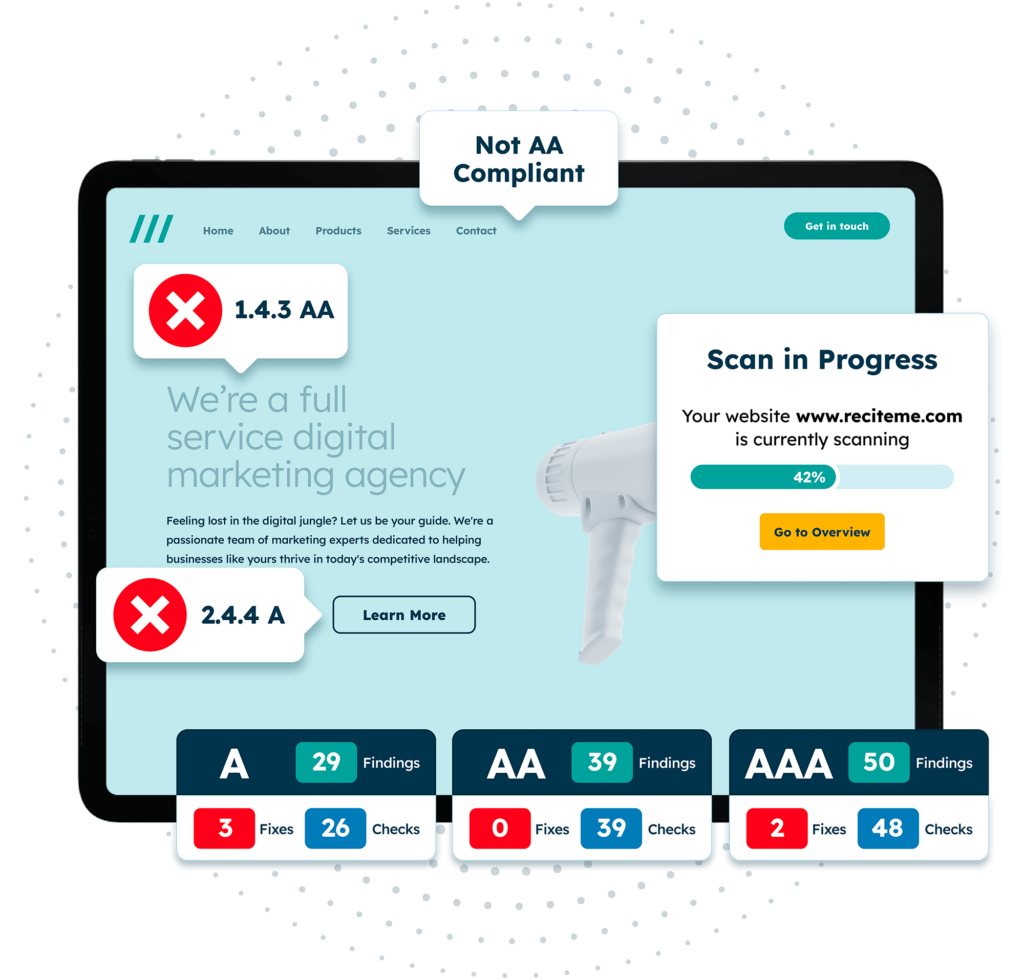
What are the most common ADA compliance issues found at WooCommerce stores?
Once you have a grasp of the potential compliance issues, you’ll find them easier to spot on your website. Below we’ve covered some of the most common ADA compliance issues – and how to put them right.
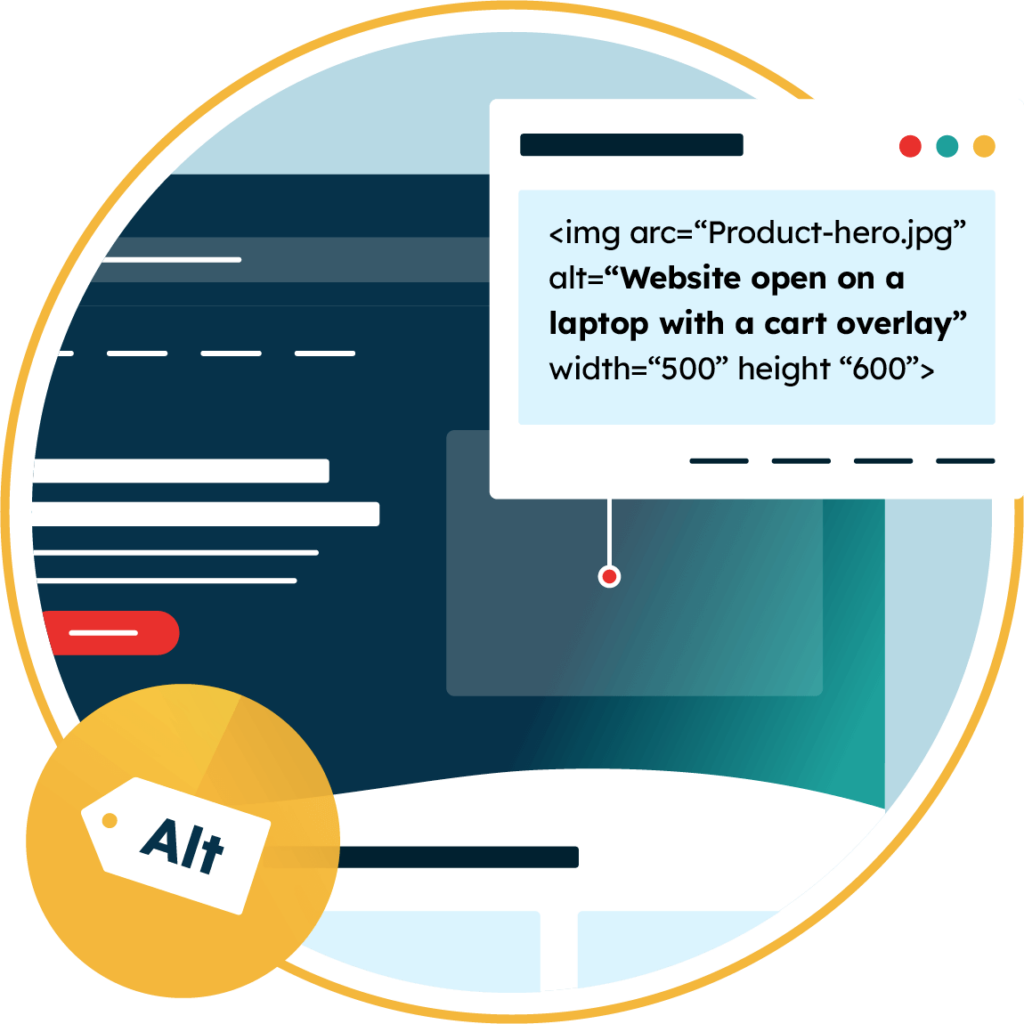
Missing or non-descriptive alt-text
Images provide essential information on your WooCommerce site, allowing customers to view your products and designs. But what about blind and visually impaired people?
Ultimately, they can’t visually “see” your images. This can lead to them missing out on vital contextual information.
The solution:
For ADA compliance, any relevant images should have descriptive alt-text. This alternative text provides a short textual description of the image, including its context, where needed. Screen readers can then read out the description to the web user.
You can add alt-text to images in the WordPress Media Library. Just click on the image and type your alt-text into the Alt Text field.
Inaccessible navigation
Web users with physical and motor disabilities may struggle with using a mouse. Some require keyboard-only navigation, or use assistive technology that relies on keyboard accessibility.
So, if interactive elements on your website are inaccessible or out-of-order, navigating your website gets confusing. In some cases, disabled people may not be able to use your website at all.

The solution:
Make sure that interactive elements like navigation menus, links, and buttons are keyboard-accessible. You can test this by navigating through your website with the Tab, Enter, and Arrow keys. You should also test with assistive tech, and make sure there is a clear order to the tabs on your website.

Text and audio alternatives for video
Video content is essential for illustrating your products. However, deaf people and those with auditory impairments won’t be able to hear the audio. Similarly, blind and visually impaired people won’t see your videos.
The solution:
Text alternatives ensure disabled people don’t miss out on any auditory or visual information. There are three main kinds of text and audio alternatives to use in ADA-compliant videos. These are:
- Captions: This refers to synchronized, on-screen text that describes the dialogue and sound effects in a video.
- Transcripts: Like captions, these are text versions of the audio content, but are displayed on a separate page or downloadable document.
- Audio descriptions: These capture the visual content of your video in auditory descriptions, which are then played between gaps in the dialogue.
Poor semantic structure
According to data from WebAIM, 39% of all web pages had skipped heading levels. Webpages with an incorrect heading hierarchy can be difficult for those with cognitive disabilities to read. On top of this, they can also make navigation challenging with assistive technology devices.

The solution:
Ensure you structure your webpages accurately. Don’t just put headings in bold. Sections should have clear, semantically-correct HTML headings. So, the title should be a H1, followed by H2s, then H3s for subheadings. Include visible skip links to help people who use screen readers to skip to the main body text.
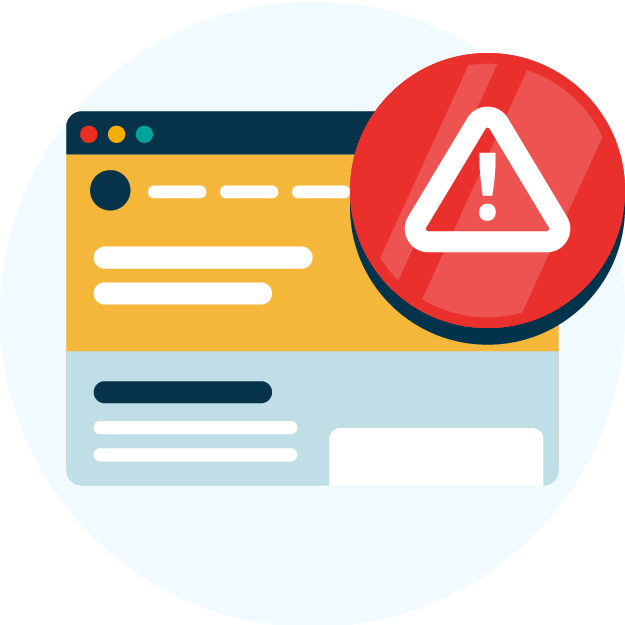
Inaccessible forms
Customers use your web forms to make accounts, check out their purchases, and make customer service queries. Poorly labeled fields and absent error messages make it difficult for users to understand how to complete a form. Sadly, it’s a very common issue, with around 34% of form inputs labeled incorrectly.
The solution:
To resolve this issue, make sure form fields and error messages are clearly labelled with the <label> tag or aria-label/aria-labelledby. Aside from providing additional clarity, accessible web forms ensure that people who use screen readers have the full context.
No descriptive links
Accessible hyperlinks help your customers to move between pages on your WooCommerce site. But when your link text only says “click here”, people who use screen readers will have no context for where the link leads.

The solution:
Make sure your link text is descriptive, so that users can understand the intended destination or action. For example, rather than “click here”, write “visit our accessibility blog”. Another bonus of descriptive links is that they can improve your SEO rankings.
Poor color contrast
Reduced vision and color-blind web users may struggle to read low color-contrast text. This is a very common issue, affecting nearly 80% of all home pages.
The solution:
You’ll need to ensure that your text has a suitable contrast against the background. So, typically a dark text on a light background is best. WCAG Level AA requires a minimum color contrast of 4.5:1 for average-sized text.
You can use a color contrast checker during the design and development phases to make sure the website palette meets WCAG requirements.
Address non-compliance on your website with an accessibility check
So, how do you find the ADA compliance issues on your WooCommerce store?
A quick and easy option is to use an accessibility auditing tool like Recite Me’s web accessibility checker. This tool conducts an audit of your website’s front and back end with over 390 WCAG-compliant scans. Once the automated scan’s complete, you’ll receive a report with a list of compliance issues to resolve.
The list is separated into “fixes”, which are confirmed compliance issues, and “checks”, which will need to be clarified by a human. It also provides tools for tracking your web accessibility progress, so you can visualize the improvements as improvements are made.
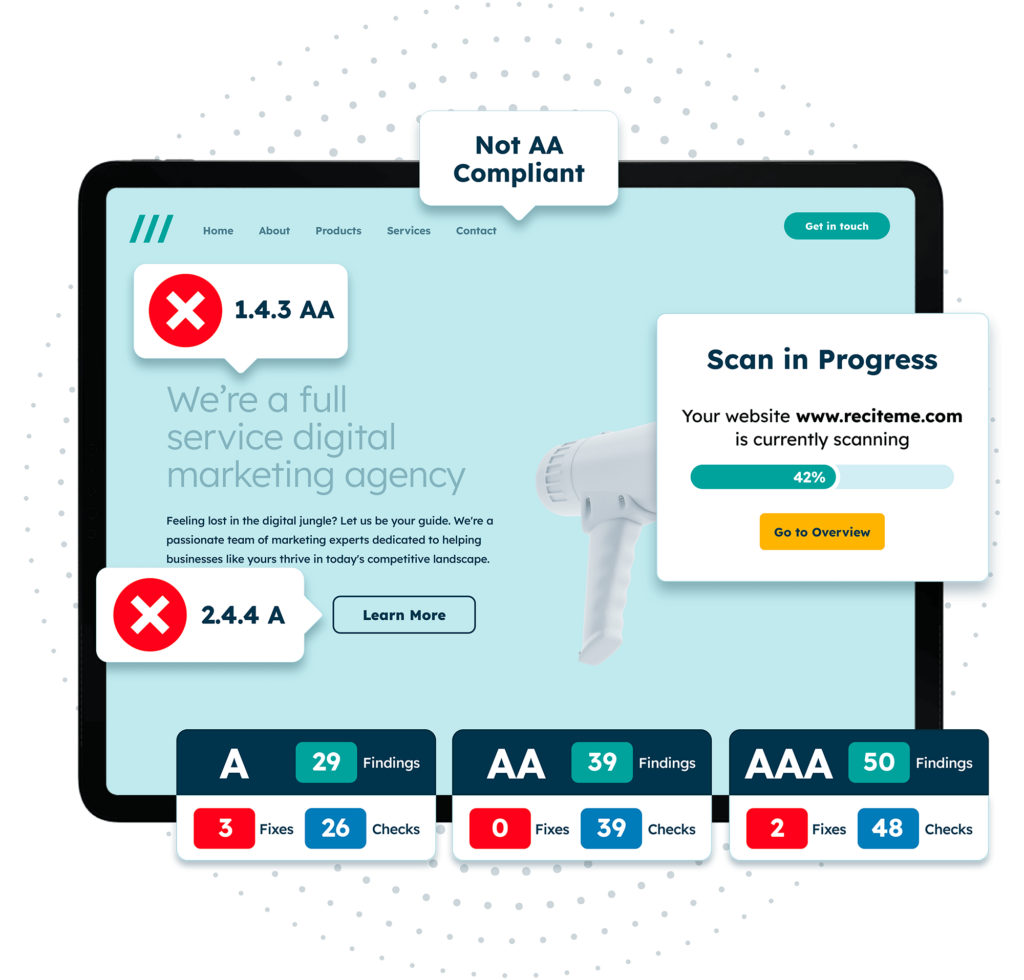
You’ll also have all the tools you need to share your ADA compliance status, including accessibility scoring and tailored monthly reporting.
What are the risks of ignoring ADA compliance?
ADA compliance can have a huge impact on disabled internet users. It removes barriers, creating fairer digital spaces. Aside from the moral benefit, making your WooCommerce site compliant also helps you to avoid the major risks associated with inaccessible websites.
ADA lawsuits and fines
Between 2018 and 2025, 25,000+ digital accessibility lawsuits have been filed. If your website is not ADA compliant, you could face legal action.

Title III of the ADA covers “public accommodations”, which has been interpreted to include business websites and apps in lawsuits. There are many costs associated with ADA compliance lawsuits, including:
- Fines: For a first violation, ADA fines start at $55,000. Subsequent violations will set you back $110,000 each.
- Compensation: You may also be required to pay compensation to the plaintiff, such as for emotional distress.
- Attorney fees: These can be very costly, particularly as the court may also require you to pay the plaintiff’s fees as well.
- Remediation costs: You’ll also have the costs of ADA website remediation, which may require accessibility training or consulting services to complete. Your staff will also have to take time (and funds) away from other important projects to work on remediation.
Poor brand image
Data from the CDC shows that 28.7% of American adults have a disability. Naturally, disability inclusion is an important issue for many people. Poor compliance and ADA lawsuits can have a detrimental impact on your brand image, leading to social media backlash. Beyond that, 52% of Americans report boycotting businesses in protest, according to data from YouGov.

Revenue decline
As your brand PR suffers, your revenue will also be put at risk. Aside from losing customers over ethical concerns, the accessibility barriers will still be in place. That means you’ll be losing out on your disabled customers.
The collective spending power of the disabled community (and their family and friends) is estimated at a whopping $13 trillion. Neglecting disabled customers is bad for ethics, and your bottom line.
The importance of continuous testing for WooCommerce stores
ADA compliance testing isn’t a one-off solution. Changes to accessibility legislation can happen, and new assistive technologies can be released. Plus, your team will be adding new product pages and blog posts all the time. Your WooCommerce website needs to stay on top of these developments.
Continuous testing ensures that your website avoids new accessibility barriers. Along with training and staying aware of WCAG updates, aim to schedule regular accessibility audits. Always make sure to follow-up automated checks with a manual, human-led audit to ensure no issues are missed.
Want to make sure your website is compliant with the Americans with Disabilities Act? Then unlock the ADA compliance checklist now. Discover actionable steps to ensure ADA compliance, helping you avoid lawsuits and any other negative consequences of non-compliance.
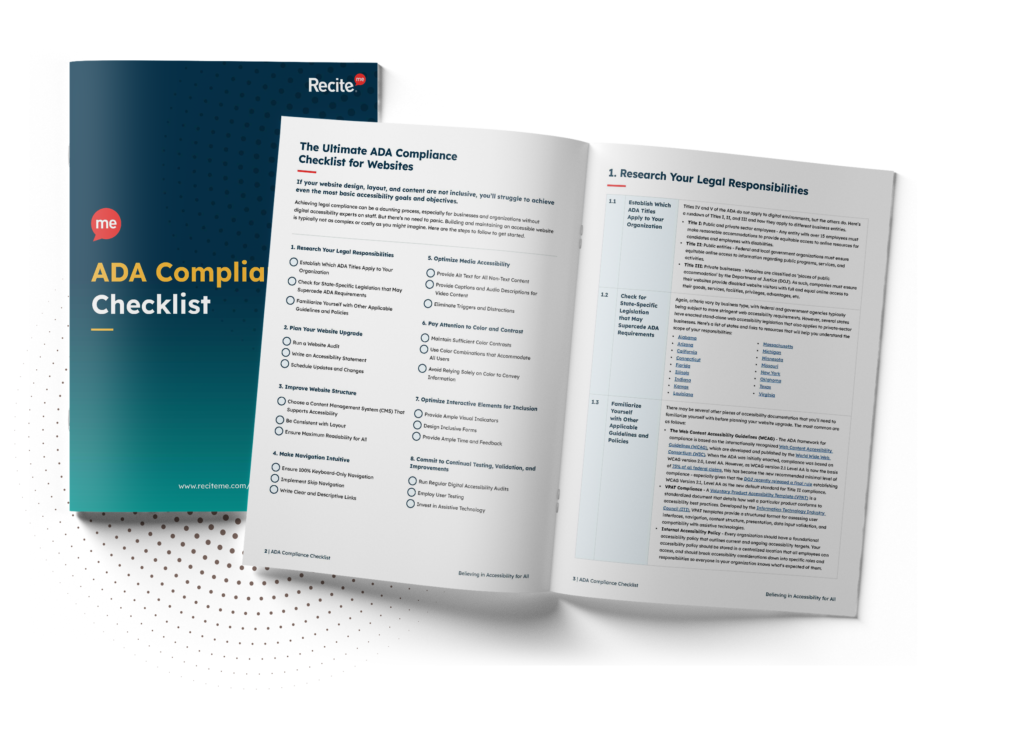
Make sure your WooCommerce Store is ADA compliant now!
ADA compliance ensures that all people can browse, buy, and do everything they need to on your WooCommerce store. Without meeting this criteria, you run the risk of lawsuits and negative PR.
Most importantly, though, your ADA compliance ensures a fairer internet. If you value digital inclusivity, then make a start today with a free ADA compliance audit. And if you’re looking for long-term awareness in your team, try Recite Me’s free accessibility training.
WooCommerce ADA compliance FAQs
Looking for a recap or quick summary? Here are a few of our most frequently asked questions to help you get to grips with the essentials:
Is WooCommerce ADA compliant?
WooCommerce stores are not necessarily ADA compliant. It’s the responsibility of the store owner to ensure their website complies with the ADA by adhering to WCAG standards.
The platform does have accessibility features, such as keyboard-only navigation, but keep in mind that an inaccessible theme can override them.
What are the limitations of WooCommerce accessibility?
The biggest limitation of WooCommerce accessibility is that the standard accessibility features can be overridden by inaccessible themes. Businesses should be very careful to choose accessible themes.
It’s not always easy to tell if your store is ADA compliant. You can use a web accessibility checker to pinpoint potential issues.
What happens if a WooCommerce website is not ADA compliant?
If your WooCommerce website is not ADA compliant, you could be breaching Title III of the ADA, which requires “public accommodations”, including company websites, to be accessible to disabled people. This puts your business at risk of costly lawsuits and fines, as well as a damaged reputation.
How do I add ADA compliance to my WooCommerce website?
You can make your WooCommerce site ADA compliant by adhering to the Web Content Accessibility Guidelines 2.1 Level AA. These guidelines illustrate the gold standard for online web accessibility. Required changes include improved color contrast, video captions, and removing/adjusting flashing content that could cause seizures.
What does an ADA-compliant WooCommerce website look like?
ADA-compliant WooCommerce websites are fully-accessible to disabled people, so they can enjoy your website to the same standard as an able-bodied person. Required adjustments include:
- Captions, transcripts, and audio descriptions for video content
- Semantically correct HTML and ARIA roles
- Screen reader and keyboard-only navigation enabled
- Clear fonts and color contrast
Need more help becoming ADA compliant?
The following resources are packed full of actionable tips and expert advice for making your digital content compliant with the Americans with Disabilities Act:
Free ADA Accessibility Training
Take the first step to ADA compliance by completing our training course.
Free ADA Accessibility Guide
Ensure your organization is meeting the requirements for ADA compliance.


